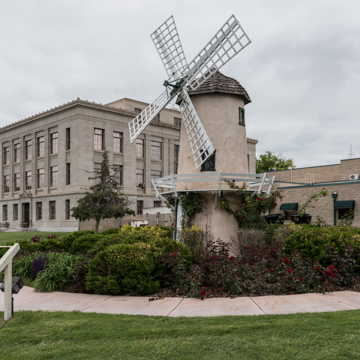Combining Neo-Renaissance and Neoclassical elements with Moderne massing, this three-story, rectangular courthouse of Indiana limestone sits on a granite-walled basement. The symmetrical north facade has full-height pavilions projecting from each end with vertical, windowless bays. The smaller upper panels have carved bison and corn motifs, while the central entablature features four bewigged judges. Over centered double doors of bronze with leaded glass panes, the pediment is ornamented with an eagle crowned by a nine-petaled flower and an engraved entablature. Inside are brass chandeliers, ceiling stenciling to echo exterior details, and local cattle brands incised in the friezes. The well-preserved interior retains its terrazzo floors and staircase, brass and wood fixtures, and coffered ceilings. The elaborate courtroom on the third floor has its original dark walnut furnishings and a stenciled, barrel-vaulted ceiling. The Post-modern Prowers County Jail (1992) is on the south end of the courthouse block.
You are here
Prowers County Courthouse
If SAH Archipedia has been useful to you, please consider supporting it.
SAH Archipedia tells the story of the United States through its buildings, landscapes, and cities. This freely available resource empowers the public with authoritative knowledge that deepens their understanding and appreciation of the built environment. But the Society of Architectural Historians, which created SAH Archipedia with University of Virginia Press, needs your support to maintain the high-caliber research, writing, photography, cartography, editing, design, and programming that make SAH Archipedia a trusted online resource available to all who value the history of place, heritage tourism, and learning.










